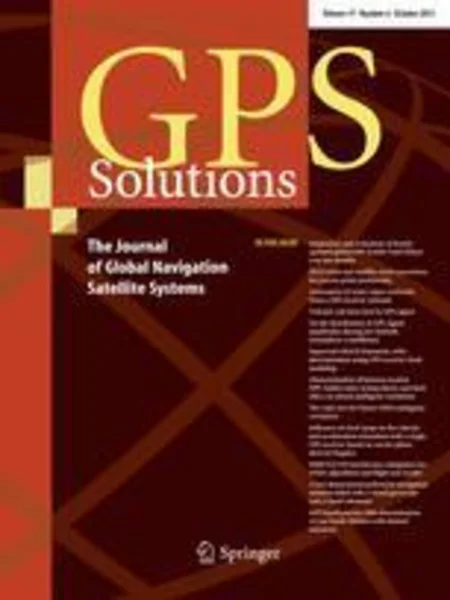-
application of the taiwan ionospheric model to single-frequency ionospheric delay corrections for gps positioning
جزئیات بیشتر مقاله- تاریخ ارائه: 1392/07/24
- تاریخ انتشار در تی پی بین: 1392/07/24
- تعداد بازدید: 1078
- تعداد پرسش و پاسخ ها: 0
- شماره تماس دبیرخانه رویداد: -
the performance of a three-dimensional ionospheric electron density model derived from formosat3/cosmic gps radio occultation measurements, called the taiwan ionosphere model (twim), in removing the ionospheric delays in single-frequency pseudorange observations is presented. positioning results using twim have been compared with positioning results using other ionospheric models, such as the klobuchar (klob) and the global ionospheric model (gim). c/a code pseudoranges have been observed at three international gps service reference stations that are representative of mid-latitude (bor1 and irkj) and low-latitude (twtf) regions of the ionosphere. the observations took place during 27 geomagnetically quiet days from april 2010 to october 2011. we perform separate solutions using the twim, klob, gim ionospheric models and carry out a solution applying no ionospheric correction at all. we compute the daily mean horizontal errors (dmean) and the daily rms (drms) for these solutions with respect to the published reference station coordinates. it has demonstrated that tec maps generate using the twim exhibit a detailed structure of the ionosphere, particularly at low-latitude region, whereas the klobuchar and the gim only provide the basic diurnal and geographic features of the ionosphere. also, it is shown that even for lower satellite elevations, the twim provides better positioning than the klobuchar and gim models. specifically, using twim, the difference of the uncorrected solution (no ionospheric correction), and the other solutions, relative to the uncorrected solution, is 45 % for the mean horizontal error (dmean) and 42 % for the horizontal root-mean-square error (drms). using klobuchar and gim, the percent for dmean only reaches to about 12 % and 3 %, while the values for the drms are only 12 and 4 %, respectively. in the vertical direction, all models have a percentage of about 99 and 70 % for the mean vertical error (vmean) and vertical root-mean-square error (vrms), respectively. these percentages show the greater impact of twim on the ionospheric correction compared to the other models. in at least 40 % of the observed days and across all stations, twim has the smallest dmean, vmean, drms, and vrms daily values. these values reach 100 % at station twtf. this shows the overall performance of twim is better than the klobuchar and gim.
مقالات جدیدترین رویدادها
-
استفاده از تحلیل اهمیت-عملکرد در ارائه الگوی مدیریت خلاقیت سازمانی و ارائه راهکار جهت بهبود
-
بررسی تاثیر ارزش وجوه نقد مازاد بر ساختار سرمایه شرکت های پذیرفته شده در بورس اوراق بهادار تهران
-
بررسی تأثیر سطح افشای ریسک بر قرارداد بدهی شرکت های پذیرفته شده در بورس اوراق بهادار تهران
-
بررسی تأثیر رتبه بندی اعتباری مبتنی بر مدل امتیاز بازار نوظهور بر نقد شوندگی سهام با تأکید بر خصوصی سازی شرکت ها
-
تأثیر آمیخته بازاریابی پوشاک ایرانی بر تصویر ذهنی مشتری پوشاک ایرانی (هاکوپیان)
-
عوامل خطر ساز بیماری های قلبی- عروقی در بندر بوشهر بر اساس پروژه مونیکای سازمان جهانی بهداشت؛ پروژه قلب سالم خلیج فارس
-
تاثیر تمرین های تقویتی بر شاخص های بیومکانیکی راه رفتن در بیماران همی پارزی مزمن ناشی از سکته مغزی
-
بررسی تاثیر مکش بافتی اولیه بر پتانسیل رمبندگی خاک
-
عملکرد میراگرهای ویسکوز و اصطکاکی در بهبود پاسخ لرزه ای سازه های جداسازی شده ی جرمی
-
تظاهرات دهانی کودکان مبتلا به hiv
مقالات جدیدترین ژورنال ها
-
مدیریت و بررسی افسردگی دانش آموزان دختر مقطع متوسطه دوم در دروان کرونا در شهرستان دزفول
-
مدیریت و بررسی خرد سیاسی در اندیشه ی فردوسی در ادب ایران
-
واکاوی و مدیریت توصیفی قلمدان(جاکلیدی)ضریح در موزه آستان قدس رضوی
-
بررسی تاثیر خلاقیت، دانش و انگیزه کارکنان بر پیشنهادات نوآورانه کارکنان ( مورد مطالعه: هتل های 3 و 4 ستاره استان کرمان)
-
بررسی تاثیر کیفیت سیستم های اطلاعاتی بر تصمیم گیری موفق در شرکتهای تولیدی استان اصفهان (مورد مطالعه: مدیران شرکتهای تولیدی استان اصفهان)
-
بررسی نقش مذهب در تحلیل شخصیت قهرمان داستان در نمایشنامه های برگزیده اول، دوره هشتم تا دهم جشنواره تئاتر رضوی
-
کاوشی در تکنولوژی فکر از منظر اسلام با رویکرد جامعه شناختی
-
وظایف و مسئولیت مدنی شهرداری شهرستان بافت
-
boron nitride nanocone as an adsorbent and senor for ampicillin: a computational study
-
the effect of suffusion phenomenon in the increasing of land subsidence rate




سوال خود را در مورد این مقاله مطرح نمایید :